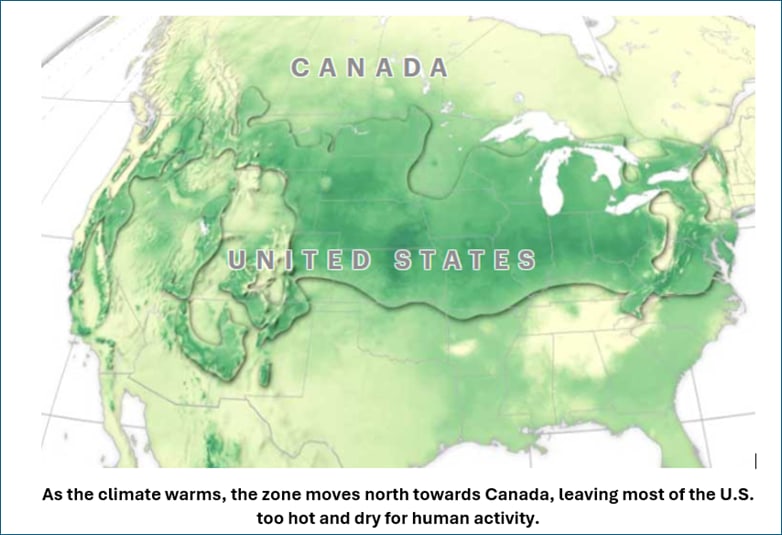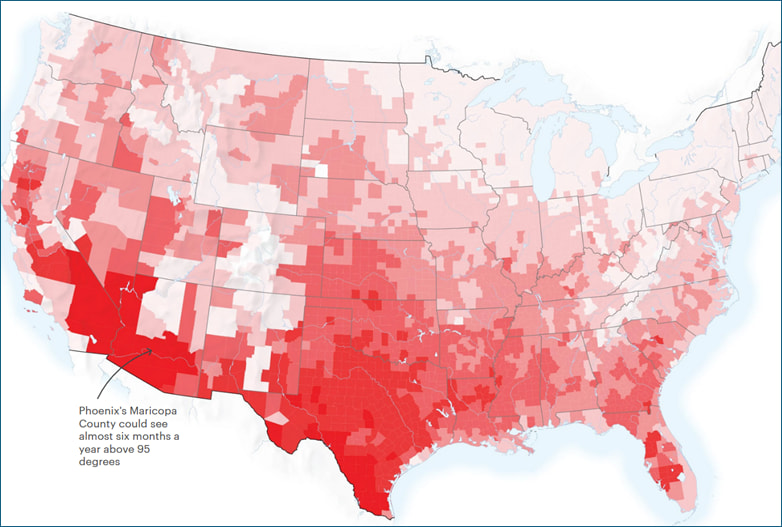Insurance companies will help pack their bags.
Within the coming two or three decades, Americans could be pushed by a punishing climate to migrate across the border and become Canadians.
The insurance industry would hustle them along.
The study casts its vision ahead by the same number of years that has transpired since the 2001 attack on the US in 9/11 – which many of us regard as “recent events” or “lifespan history”. We are not talking about incomprehensibly large eras here.
Disaster is not that far away, is the point.
The study was done by the Rhodium Group, an independent research provider, and analyzed by the non-profit newsroom ProPublica and The New York Times Magazine.
It indicated that warming temperatures and changing rainfall will drive agriculture and temperate climates northward, while sea level rise will consume coastlines and dangerous levels of humidity will swamp the Mississippi River valley.
The most habitable climate in North America will shift northward.
The push is coming from the continued burning of fossil fuels – an event the fossil fuel companies have known about for nearly five decades. Their lobbying has kept the burn rate high: reflect on Trump’s insistence on “drill baby drill” and his cancellation of renewable energy plans.
Public policies make all the difference; China today is decreasing its output of air pollution as its solar and wind farms accelerate.

Between 2040 and 2060 heat will be the prime mover, with extreme temperatures commonplace in the South and Southwest. Some counties in Arizona could experience temperatures above 95 degrees for half the year.

In parts of the Midwest and Louisiana it could be difficult for the human body to cool itself during several days every month. The risk of heat stroke death is multiplied by the combination of sun angle, wind speed and cloud cover reacting to high temperatures.
The likelihood also rises that very large wildfires burning over 12,000 acres each will affect the West, Northwest and the Rocky Mountains, but also Florida, Georgia and the Southeast.
Growing food will become difficult across large parts of the country, including the heart of the High Plains’ $35 billion agriculture industry.
All the while, sea level rise will transform the coasts. The rise will affect only a small sliver of US land, but it is a very highly-populated region with high property values.

Fifty million Americans (map, L) live in eight of the largest metro areas – including New York, Boston and Miami – which will be most affected. The financial toll (map, R) will exceed the damage caused by the Covid pandemic.
Together, the compounding calamities could see a mass migration of Americans away from southern and coastal distress areas to the northern Midwest and Great Plains – and Canada.
There are pluses to that: free healthcare service, the highest education rate in the world, and life amid the happiest country on Earth. It is the first place on Earth to adopt multiculturalism as a core part of its national identity. My grandson’s kindergarten class sings “Happy Birthday” in English, French and Arabic.
And almost everywhere you go, you can get poutine.
The downside is that you have to check your guns at the border, and get used to living in a place where guns are not needed.
This need not be your future.
Private enterprise could save the day.
Now, US banks are slashing their fossil fuel spending because it now carries more risk when compared to funding grid upgrades, battery plants or renewable energy developers. Wall Street’s six largest banks have cut their financing to oil, gas and coal projects by 25% year-on-year through August 1, 2025. In dollar terms, that means about $73 billion this year versus roughly $97 billion in the same period in 2024.
There is another force at work.

When the world’s largest risk assessment company says that climate change is an enormous risk for the insurance industry, even legislators need to listen.
Blackrock manages $9.42 trillion in assets. It just launched a study that revealed that 95% of global insurers believe that climate risk is an investment risk.
Echoing their colleague, a board member at Allianz, one of the world’s biggest insurers, recently confirmed that financial services such as mortgages and investments are at risk. Gunther Tallinger said the world is fast approaching temperatures that make it impossible for insurers to offer cover.
Tallinger noted that some two-thirds of economic losses from natural catastrophes are currently uninsured; he labelled this a “major societal problem.”
Some insurers fear the world is fast approaching temperature levels where professional risk managers will no longer be able to offer cover for financial services. Zurich Insurance Group, meanwhile, said alongside a recent research paper assessing climate resilience that the outlook looks “alarmingly bleak.”
If these disasters are uninsured, the financial burden often falls on individuals, businesses and governments.
“We could end up with an unbearable societal situation where there is just too much risk that is no longer covered.”
The Los Angeles wildfires are a demonstration that even the world’s wealthiest economies are unprepared for the impact of increasing climate risks.
Global insured losses have grown at a much faster rate than the global economy over the past three decades. The rising temperatures are warming the oceans, shrinking the ice sheets, melting the glaciers, destroying the snow cover, raising the sea level, adding to air pollution and health problems, increasing the number of extreme weather events, and increasing the acidity of the surface ocean water.
Estimates are that the world GDP would be 37 per cent higher today had no global warming occurred over the past 30 years.
One factor in the rise of damage claims is that people want to live on the coast. Coastal areas are getting lacerated by a series of storms that get a power boost from climate change. Florida property owners for example pay more than four times the national average for home insurance. Six of the 10 most expensive cities in the U.S. for homeowners insurance are in Florida.
But no region escapes unscathed. The East Coast of Canada is one of the areas of the world that is a severe hotspot for precipitation whiplash. This threatens to unleash cascading hazards that – in the words of one expert – “pose unprecedented stress to ecosystem services, existing infrastructure, water and food security, and human safety.”
Nova Scotia’s climate has become relentlessly warmer over the past 100 years. The growing season has extended 40 days since 1913. This is perfectly in line with the Rhodium study.
While it has some agricultural advantages, it also upsets the province’s environmental matrix, with fiercer storms, rising water levels, and increasing fire hazards. Nova Scotia now has a completely different climate – and climate challenges – than it did a single generation ago. These changes have created new weather patterns that are drastically different from the historic models we have seen before.
This has implications for the increasing severity of storms that hit the province. It means rising storm waves, higher winds, faster coastal erosion, and more flooding. In addition, it affects the spread of disease, with rising temperatures being responsible for higher incidences of pathogens from Lyme Disease to Covid.
It is therefore unsurprising that the province has taken a lead in exploring ways to mitigate these dangers to life and livelihood.
One solution that is coming increasingly to the fore is digital: Digital Twin technology. Digital Twins take detailed environmental information from sensors across the region, run it through an AI program, and identify critical issues in real time. Its virtual model of physical infrastructure supports risk assessment, scenario planning, and operational decision-making.
International projects, such as the EU-funded PANTHEON initiative, are developing community-based smart digital twin platforms specifically for disaster resilience and risk management. In Canada, experts highlight the potential for digital twins to help regions like those in Atlantic Canada—including storm-tossed Nova Scotia—better prepare for and respond to natural disasters, especially in the face of recent severe weather events.
Digital Twins offer a thorough grasp of a region’s infrastructure, encompassing structures, utilities, transit systems, and environmental factors. combining information from multiple sources, including social media feeds, satellite photography, sensors, and IoT devices. DTs help emergency responders and planners better prepare for, prevent, and handle calamities. They deliver timely, granular, geo-located early warnings and alerts for hazards relevant to individuals’ specific locations of concern (home, work, school, current location) via SMS and mobile app notifications.
Ultimately, they give decision-makers a comprehensive picture of each crises as they develop using continuously updating real-time data feeds, empowering them to make wise decisions in quickly changing situations, and empowering citizens to select appropriate courses of action during a climate disaster.
Digital Twins could be the key to ameliorating the fundamental problem of the reduction in greenhouse gas emissions. They connect the cause of the emission to the effect of a climate change, and visualize the outcome.
The technology pits computer power against environmental decay. It will be of great interest to follow the Nova Scotia experiment, and assess its value for other areas.
Canadian Prime Minister Carney pointed out early in his book “Building a Better World for All”, that “Climate change is the ultimate betrayal of intergenerational equity. It imposes costs on future generations that the current generation has no direct incentives to fix.”
There is one incentive, in fact, that may make a huge difference.
It is driven by the banking and financial sectors.
And, in the longer term, by those Americans who do not fancy having to move north into a foreign country just to be able to walk outside without sunscreen 5000.
My own intuition tells me that once America has driven over the Trump speed-bump, it will rapidly switch to renewables and a clean future for our children.
Because once Americans get behind something, it gets done very fast.
What is forecast, is not what is immutable.
Our children are counting on it.
Thank you for following Barry’s Substack
To help do something about the climate change and global warming emergency, click here.
Sign up for our free Global Warming Blog by clicking here. (In your email, you will receive critical news, research, and the warning signs for the next global warming disaster.)
To share this blog post: Go to the Share button to the left below.
